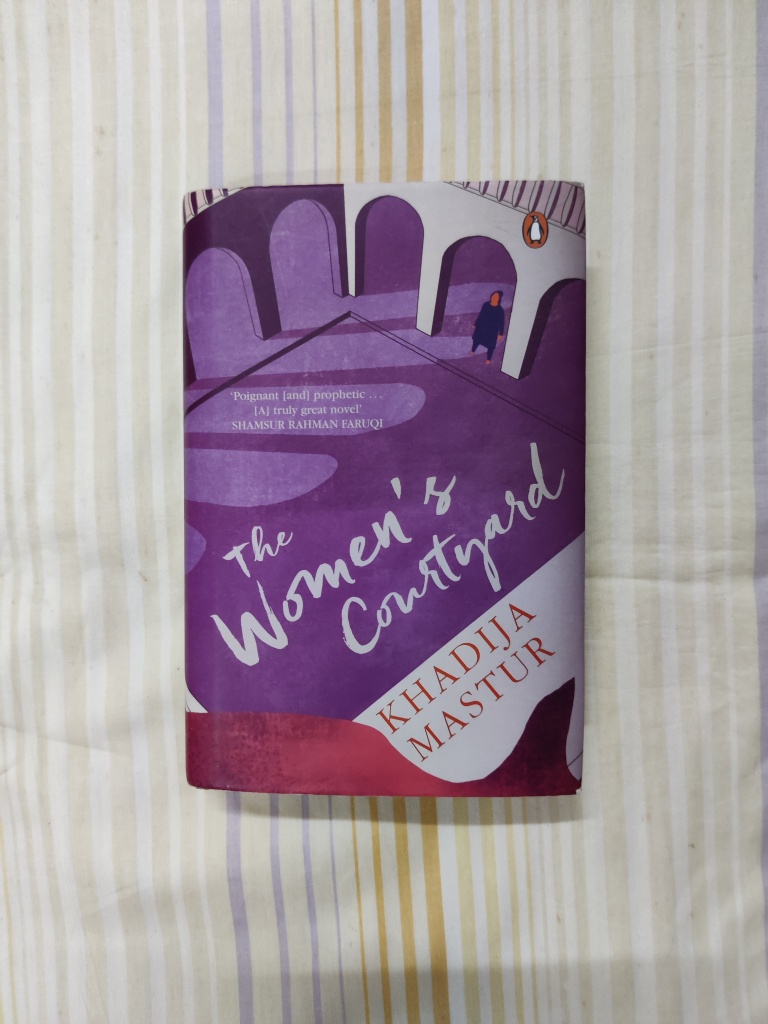After reading Hajra Masroor’s short story collection, I decided to read one of the novels by her sister, Khadija Mastur, and so I picked up this one.

The story told in ‘Aangan‘ (translated as ‘The Women’s Courtyard‘) starts sometime in the 1930s, before the advent of the Second World War, and ends sometime after the independence of India and Pakistan. Most of the story happens inside one house, and we see events unfolding inside the house, and we hear about external events, through the conversations between different characters. This gives it the feel of a play. Outside the house, important historical events are unfolding, like the struggle for independence from British rule, the Second World War, and later the aftermath of war, the violence of Partition, and the initial days of the two newly independent countries, India and Pakistan. But we see these through the events happening inside a home, when a family member is arrested for protesting against the British, when the family is struggling for basic provisions because of the onset of war, how the Partition divides this particular family into two and separates them permanently. I found this way of telling the story fascinating. Many heartbreaking things happen in the story, which are surrounded by acts of kindness and beautiful scenes. I won’t tell you anything about them. I’ll leave you to discover them yourself.
The main characters in the story are mostly women. We see the story unfold through one of the main characters, Aliya. She was one of my favourite characters too. She defies the societal norms and restrictions of her time, gets herself an education, goes to work, and even volunteers to teach poor children, much against the wishes of her own mother. I also loved Chammi, Aliya’s cousin and best friend, who is a rebel in her own way. Aliya’s mother is one of those matriarchs whom we hate from the first scene. The ending of the story is very interesting, and it must have been very pathbreaking for its time. Whether it is happy or sad – you need to read the book to find out.
Khadija Mastur’s writing is spare and simple and the pages just fly. There is a beautiful afterword at the end of the book in which the translator Daisy Rockwell puts the book in context and explains why it is a feminist classic. It is beautiful to read. I loved this particular part of that afterword –
“In 1985, the American cartoonist Alison Bechdel created a comic strip depicting a conversation between two women complaining about the male-centric nature of most Hollywood films. One woman tells the other she will only go to movies that 1) have at least two women with distinct identities in them; 2) feature women talking to one another, and 3) portray women talking to each other about something besides a man. This set of three criteria has come to be known as the Bechdel Test, and most films and many books the world over continue to be so infused with patriarchy that they do not pass muster in these terms. Thanks to Mastur’s formal experiment, ‘The Women’s Courtyard’ passes the Bechdel Test with flying colours, despite being set in a strongly patriarchal milieu. Mastur does not eliminate male voices; far from it – the men in the family all play prominent roles in the narrative. But her choice makes it possible to privilege women’s voices. In this way she also foregrounds an anti-patriarchal feminist politics.”
The part of the afterword I hated was where Daisy Rockwell takes potshots at the previous translator of the book, Neelam Hussain, and tries to prove why her translation is better. I hate it when translators do that. Though out of the three examples that Daisy Rockwell quoted, I agreed with her on two of them. There was no need for taking potshots though. Daisy Rockwell has also translated Bhisham Sahni’s classic novel ‘Tamas’. The previous version of the translation was done by the author himself. So is Daisy Rockwell going to take potshots at the author himself now?
‘The Women’s Courtyard’ is one of the classics of Pakistani Urdu literature. I loved it. It brought back that era alive and I loved how the story is mostly told from the women characters’ perspective. I’m hoping to read Khadija Mastur’s second novel now.
Have you read ‘The Women’s Courtyard’? What do you think about it?